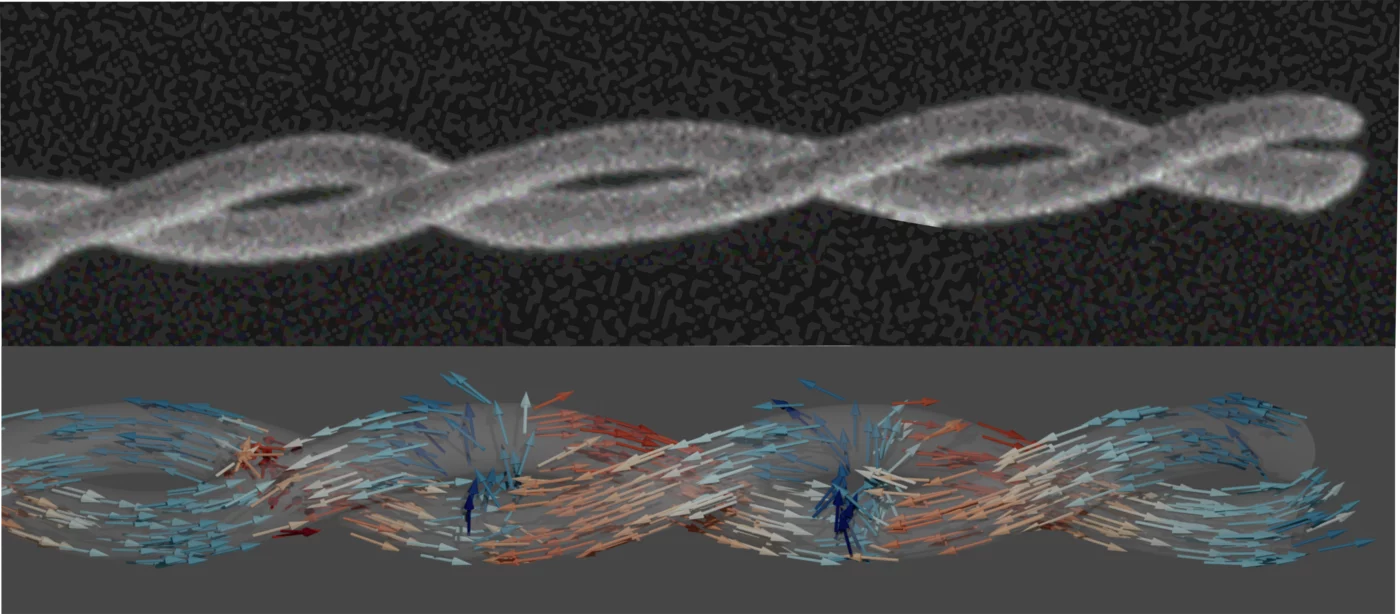A combination of advanced 3D printing and microscopy has enabled researchers to gain new insights into what happens while taking magnets to three dimensions on the nanoscale, which is 1000 times smaller compared to a strand of human hair.

Image Credit: Claire Donnelly (CD), MPI CPfS.
Headed by Claire Donnelly, the leader of Max Planck Institute’s new independent group, Spin3D, formerly of the University of Cambridge, an international research group employed a new 3D printing method designed by them to develop magnetic double helices — similar to the double helix of DNA. The magnetic double helices twist around one another, exhibit chirality and curvature and have powerful magnetic field interactions between one another.
This way, the researchers found out that the magnetic double helices could produce nanoscale topological textures in the magnetic field. This was something that had never been observed earlier. The new findings help set the stage for the next generation of magnetic devices and have been reported in the Nature Nanotechnology journal.
Several different parts of societies are hugely impacted by the use of magnetic devices, and magnets are utilized for data storage, the generation of energy and computing. However, magnetic computing devices are quickly approaching their shrinking limit in two-dimensional systems.
As far as the next generation of computing is concerned, there is more and more interest in shifting to three dimensions, where not just greater densities can be realized with the help of 3D nanowire architectures, but three-dimensional geometries can also alter the magnetic properties and thus provide new functionalities.
Since Stuart Parkin, leader of the MPI of Microstructure Physics in Halle, first proposed the racetrack memory, there has been increasing interest in digital data storage using magnetic nanowires to develop information storage devices that exhibit high capacity, performance, and reliability.
But this concept has always been very hard to achieve because not only should researchers be able to make three-dimensional magnetic systems but they must also comprehend the effect of going to three dimensions on both the magnetic field and the magnetization.
Consequently, in recent years, researchers have been concentrating on devising new techniques to realize three-dimensional magnetic structures — consider a CT scan in a hospital without magnets. Also, they have designed a 3D printing method for magnetic materials.
In this context, the 3D measurements were executed at the PolLux beamline of the Swiss Light Source at the Paul Scherrer Institute. This is now the only beamline that is capable of providing soft X-ray laminography. The researchers used these latest X-ray imaging methods and noted that the 3D DNA structure results in a distinct texture in the magnetization compared to what is observed in 2D.
Pairs of walls present between magnetic domains (that is, regions where all magnetization points in the same direction) in adjacent helices are highly coupled. Hence, they tend to distort. These walls attract one another and rotate due to the 3D structure, thereby “locking” into place and developing powerful, regular bonds, like that of the base pairs present in the DNA.
Besides discovering that the 3D structure results in interesting topological nanotextures in the magnetization, where such textures are observed quite often, the researchers also observed the same nanotextures in the magnetic stray field. This discloses exciting new nanoscale field configurations.
This new potential to pattern the magnetic field at such a length scale would enable determining the forces to be applied to magnetic materials and to comprehend the extent to which such magnetic fields can be patterned.
After shifting from two to three dimensions in the case of magnetization, Donnelly and her colleagues from the Paul Scherrer Institute and the Universities of Glasgow, Zaragoza, Oviedo and Vienna look forward to exploring the complete potential of shifting from two to three dimensions with respect to the magnetic field.
The potential applications of this study are extensive: the presence of such strongly bonded textures in the magnetic helices guarantee extremely robust motion and can act as a possible information carrier.
But what is more exciting is that this new possibility to pattern the magnetic field at the nanoscale could help provide new opportunities for imaging techniques, particle trapping, as well as smart materials.
Journal Reference:
Donnelly, C., et al. (2021) Complex free-space magnetic field textures induced by three-dimensional magnetic nanostructures. Nature Nanotechnology. doi.org/10.1038/s41565-021-01027-7.